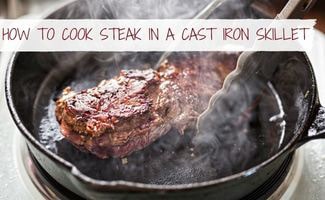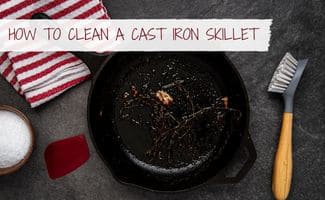How To Cook A Steak In A Cast Iron Skillet: Ribeye, Tenderloin, Skirt Steak, Multiple Steaks, Recipes, And More
 Cooking the perfect steak is an art form that not everyone has mastered. Would you like to be one of the few that can check this off their skills list?
Cooking the perfect steak is an art form that not everyone has mastered. Would you like to be one of the few that can check this off their skills list?
Indeed, preparing and cooking steak is a process that can be intimidating for the average person. How do you cook it to get the perfect sear, without overcooking? How do you know when to flip it over and finish cooking it? What preparation is needed before turning on the stove?
One critical way to ensure the perfect result is to choose the right cookware. And, once you know how to cook a steak in a cast iron skillet, you’ll never look back!
Here’s how to make sure your steak is cooked perfectly from start to finish.
Article Overview
- Learn How To Cook Steak In A Cast Iron Skillet
- Selecting An Eco-Friendly Steak
- The Best Cast-Iron Steak Recipe
- Timing Is Everything
- How To Cook Beef Tenderloin Steaks In A Cast Iron Skillet?
- How To Broil A Steak In A Cast Iron Skillet?
- Temperature, Flipping, Timing, And Resting
- Cleaning Your Cast Iron Pan
Learn How To Cook Steak In A Cast Iron Skillet
Cast iron skillets are a superior choice for cooking steak because they heat evenly and retain heat well. This means that your steak will cook more evenly, resulting in less risk of overcooking.
Another benefit of using a cast iron skillet is that the pan develops a delicious crust on the meat as it cooks. The Maillard reaction kicks in, creating a distinct flavor that you won’t find with other types of cookware. Whether you’re wondering how to cook wagyu steak in a cast iron skillet or just a simple skirt steak, you’ve chosen the right cookware.
Once your pan is hot, it’s time to start cooking! But, how do you know if the temperature is right?
One way to test the heat of your skillet before adding steak is by dropping a little bit of water into the pan. If it sizzles and evaporates immediately, the pan is hot enough.
Once the pan is preheated, you’re ready to go.
How Many Steaks Should You Cook at Once?
If your skillet is large enough, you can cook two or three steaks at a time. If it’s on the small side, just start with one. (Too many pieces in the pan will create crowding and prevent them from searing properly.)

Selecting An Eco-Friendly Steak
Here at Earth’s Friends it’s not lost on us the impact that cattle farming has on the planet. Consuming less meat is definitely the eco-friendly (and possibly health friendly) choice. But – there’s two sides to every coin. The trampling that cows do plays a role in reforestation, so completely eliminating cattle might not be the answer either.
Choosing a local, grass-fed steak is not only supporting smaller family farms, it’s reducing pollution created by steak transit (the trip the steak makes to your cast iron), and it’s also supporting more humane treatment of cows. But the best part is a pasture-raised grass fed steak tastes way better!
Plant-Based Steaks
And the good news for vegans that don’t want to use meat at all is you don’t have to use real meat to cook the perfect steak in your cast iron. Our friends over at Sauce Stache have released a 100% plant-based steak using Beyond Beef meats.
The Best Cast-Iron Steak Recipe
The best recipe will depend on your personal preference and your cut of beef. But there are a few essentials to include in your recipe for the most delicious result.
When frying a steak, a thickness of about 1 to 1 1/2 inches is ideal. (You’re likely cooking sirloin, rump, or fillet with this method.) To cook through, thicker cut steaks would need to be seared in the pan and then baked in a hot oven for a couple of minutes.
Ingredients
- One or two steaks, preferably around one inch thick
- Salt
- Pepper
- Olive oil or butter
- Garlic powder (optional)
- Fresh herbs for additional in-pan seasoning
Instructions
Season both sides of the steak with salt and pepper, then add a little bit of oil to your cast-iron skillet over medium heat on the stovetop.
Once the pan is preheated, place the steak in the hot pan for three minutes without moving it. Flip once after four minutes and let cook on the other side for three minutes. You can also press down on the steak while it’s cooking to ensure that it’s properly seared. However, be careful not to press too hard and lose those delicious juices.
Add garlic powder or fresh garlic to the pan if desired, as well as a dollop of butter. Spoon the melted butter over the steak during the final part of cooking which will keep it moist and impart the delicate taste of any added herbs to the meat.

Timing Is Everything
We’re not going to weigh in on the rare/medium/well-done debate here – we all have our preferences. But if you’re learning how to fry a steak in a cast iron skillet, then you’ll want to get your timing just right.
How long should you cook a steak for? That will depends on the thickness of your steak.
- Rare: two minutes per side
- Medium-Rare: three to five minutes per side
- Medium: five to seven minutes per side
- Well-done: eight to ten minutes per side. Or longer, if you’re cooking a thicker steak.
These cooking times are based on a steak that is about one inch thick. If your steak is thicker, then you’ll want to increase the cooking time accordingly.
How To Cook Beef Tenderloin Steaks In A Cast Iron Skillet?
On either side of the backbone, small, lean, and extremely delicate muscles known as tenderloins are the most coveted part of the animal. The buttery softness of their flesh is highly sought after.
If you’ve chosen a roast tenderloin then there is no need to sear before roasting. Just season with salt and pepper, place in a hot oven (425 degrees Fahrenheit), and roast for about 25 minutes.
For thicker tenderloin steaks, you will want to sear them before roasting. Preheat your oven to 400 degrees Fahrenheit and heat up some oil or butter in a cast iron skillet on the stovetop over medium-high heat. Thereafter pop them straight in the oven to finish up.
How To Broil A Steak In A Cast Iron Skillet?
If you’re looking for a way to get that delicious crispy crust on your steak, then broiling is the answer. And you can do it right in your cast iron skillet.
Preheat your oven to high broil (500-600 degrees Fahrenheit) and place the skillet directly under the heat source.
Add some oil or butter to the pan and sear your steak on each side for about two minutes. Then turn your oven down to a more moderate temperature (400 degrees Fahrenheit) and continue cooking for another five minutes per side or until cooked through.
Steak Secrets: Temperature, Flipping, Timing, And Resting
The finest chefs only cook their steaks once they are at room temperature. This allows the meat to cook more evenly and retain its flavor.
When it comes to cooking steak, flipping your cut of beef is a delicate art. If you flip too soon, you run the risk of losing all those delicious juices inside! If possible, only flip it once one the grill. You can rotate it 90 degrees halfway through the flip to give it the classic grill marks.
Don’t forget to let your steak rest for a few minutes before serving. This allows the juices time to redistribute, keeping them moist and delicious!
Thicker steaks may need a minute or two up on their side to ensure even cooking.
Cleaning Your Cast Iron Pan
 You’ve enjoyed your delicious steak and would prefer to go out on the patio and watch the sunset but out of the corner of your eye you notice a very greasy cast iron pan on the stove that should probably be tended to. Maybe you even have some burnt on pieces of food, and are intimidated by how to get those off. Cleaning your past iron skillet correctly is key to its longevity and maintaining its quality so you can continue to enjoy delicious meals from it.
You’ve enjoyed your delicious steak and would prefer to go out on the patio and watch the sunset but out of the corner of your eye you notice a very greasy cast iron pan on the stove that should probably be tended to. Maybe you even have some burnt on pieces of food, and are intimidated by how to get those off. Cleaning your past iron skillet correctly is key to its longevity and maintaining its quality so you can continue to enjoy delicious meals from it.



